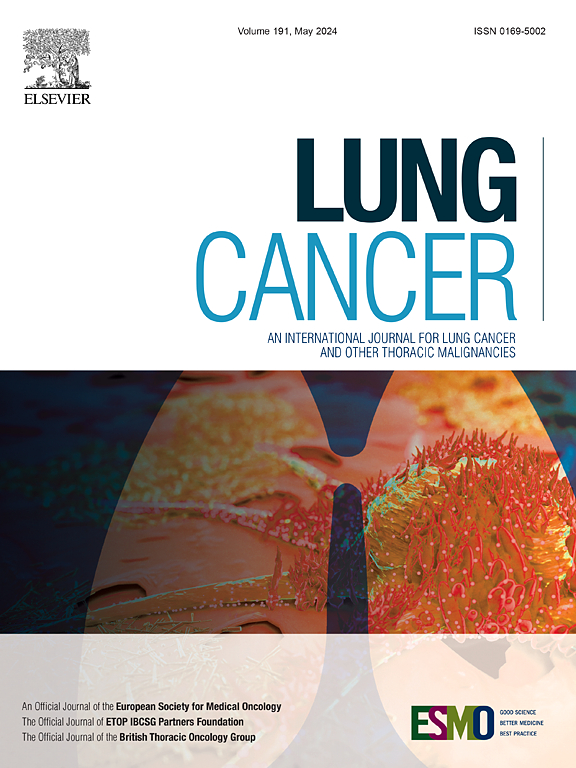局部晚期NSCLC: durvalumab时代真实世界复发模式概述(LEOPARD试验)
IF 4.4
2区 医学
Q1 ONCOLOGY
引用次数: 0
摘要
背景:尽管PACIFIC试验取得了进展,但在不可切除的III期非小细胞肺癌(NSCLC)中,化疗(CRT)后的复发以及durvalumab巩固仍然是一个重大的临床挑战。本研究旨在调查真实世界队列中的复发模式和挽救治疗的结果,为进展后管理提供见解。方法回顾性分析了2018年1月至2021年12月意大利8个中心接受PACIFIC方案治疗的166例不可切除的III期NSCLC患者。复发分为少复发(≤3个病灶可局部治疗)和多复发。报告了救助策略对总生存期(OS)的影响。结果中位随访33个月后,56%的患者出现复发;其中72%为少发性复发。少发性复发主要累及肺(34%)和脑(26%),多发生在辐射场外。少复发患者的中位生存期明显长于多复发患者(41个月对19个月)。少复发患者的抢救治疗包括放疗(45%)、化疗(35%)和CRT(13%)。单纯接受放射治疗的中位生存期为25个月,接受放射治疗的中位生存期为30个月。多发复发患者主要接受化疗(77%),中位生存期为12个月。结论:单抗复发是crt和杜伐单抗后复发的主要模式,与转移导向治疗的生存率提高有关。这些发现强调了对复发模式进行分层和整合局部挽救治疗,特别是放射治疗,在个性化管理中的重要性。需要前瞻性试验来完善挽救策略和评估新的治疗组合。本文章由计算机程序翻译,如有差异,请以英文原文为准。
Locally advanced NSCLC: overview of real-world pattern of recurrence in durvalumab era (LEOPARD trial)
Background
Despite the advances introduced by the PACIFIC trial, recurrence after definitive chemoradiotherapy (CRT) followed by durvalumab consolidation remains a significant clinical challenge in unresectable stage III non-small cell lung cancer (NSCLC). This study aims to investigate relapse patterns and outcomes of salvage treatments in a real-world cohort, providing insights for post-progression management.
Methods
We performed a retrospective analysis of 166 patients with unresectable stage III NSCLC treated with the PACIFIC regimen across eight Italian centers from January 2018 to December 2021. Recurrences were classified as oligorecurrent (≤3 lesions amenable to local therapy) or polyrecurrent. The impact of salvage strategies on overall survival (OS) was reported.
Results
After a median follow-up of 33 months, 56 % of patients experienced recurrence; among these, 72 % were oligorecurrent. Oligorecurrences predominantly involved the lungs (34 %) and brain (26 %), mostly outside the irradiated field. Median OS was significantly longer in oligorecurrent versus polyrecurrent patients (41 vs. 19 months). Salvage therapies in oligorecurrent patients included radiotherapy (RT) (45 %), chemotherapy (35 %), and CRT (13 %). Median OS was 25 months for those treated with RT alone and 30 months for those receiving CRT. Polyrecurrent patients primarily underwent chemotherapy (77 %) with a median OS of 12 months.
Conclusions
Oligorecurrence represented the predominant pattern of relapse post-CRT and durvalumab, associated with improved survival when treated with metastasis-directed therapies. These findings underscore the importance of stratifying recurrence patterns and integrating local salvage treatments, especially RT, in personalized management. Prospective trials are needed to refine salvage strategies and evaluate novel therapeutic combinations.
求助全文
通过发布文献求助,成功后即可免费获取论文全文。
去求助
来源期刊

Lung Cancer
医学-呼吸系统
CiteScore
9.40
自引率
3.80%
发文量
407
审稿时长
25 days
期刊介绍:
Lung Cancer is an international publication covering the clinical, translational and basic science of malignancies of the lung and chest region.Original research articles, early reports, review articles, editorials and correspondence covering the prevention, epidemiology and etiology, basic biology, pathology, clinical assessment, surgery, chemotherapy, radiotherapy, combined treatment modalities, other treatment modalities and outcomes of lung cancer are welcome.
 求助内容:
求助内容: 应助结果提醒方式:
应助结果提醒方式:


